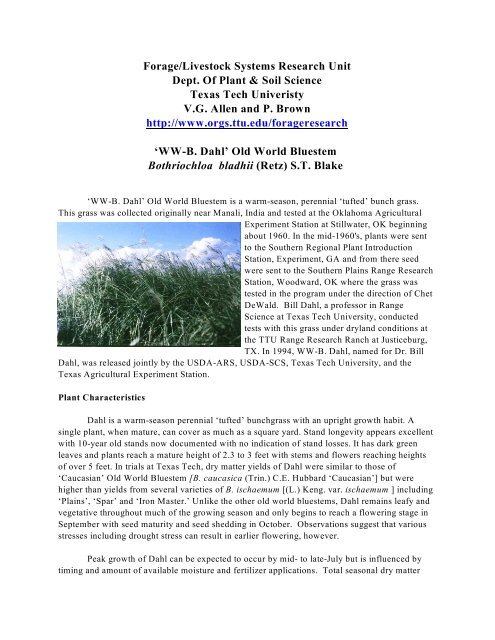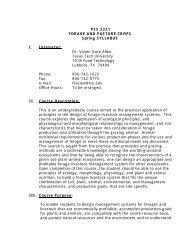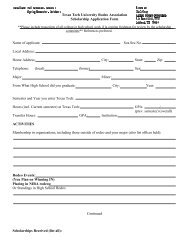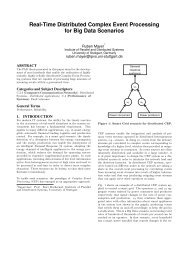WW-B. Dahl - Texas Tech University
WW-B. Dahl - Texas Tech University
WW-B. Dahl - Texas Tech University
- TAGS
- dahl
- texas
- tech
- university
- orgs.ttu.edu
Create successful ePaper yourself
Turn your PDF publications into a flip-book with our unique Google optimized e-Paper software.
Forage/Livestock Systems Research Unit<br />
Dept. Of Plant & Soil Science<br />
<strong>Texas</strong> <strong>Tech</strong> Univeristy<br />
V.G. Allen and P. Brown<br />
http://www.orgs.ttu.edu/forageresearch<br />
‘<strong>WW</strong>-B. <strong>Dahl</strong>’ Old World Bluestem<br />
Bothriochloa bladhii (Retz) S.T. Blake<br />
‘<strong>WW</strong>-B. <strong>Dahl</strong>’ Old World Bluestem is a warm-season, perennial ‘tufted’ bunch grass.<br />
This grass was collected originally near Manali, India and tested at the Oklahoma Agricultural<br />
Experiment Station at Stillwater, OK beginning<br />
about 1960. In the mid-1960's, plants were sent<br />
to the Southern Regional Plant Introduction<br />
Station, Experiment, GA and from there seed<br />
were sent to the Southern Plains Range Research<br />
Station, Woodward, OK where the grass was<br />
tested in the program under the direction of Chet<br />
DeWald. Bill <strong>Dahl</strong>, a professor in Range<br />
Science at <strong>Texas</strong> <strong>Tech</strong> <strong>University</strong>, conducted<br />
tests with this grass under dryland conditions at<br />
the TTU Range Research Ranch at Justiceburg,<br />
TX. In 1994, <strong>WW</strong>-B. <strong>Dahl</strong>, named for Dr. Bill<br />
<strong>Dahl</strong>, was released jointly by the USDA-ARS, USDA-SCS, <strong>Texas</strong> <strong>Tech</strong> <strong>University</strong>, and the<br />
<strong>Texas</strong> Agricultural Experiment Station.<br />
Plant Characteristics<br />
<strong>Dahl</strong> is a warm-season perennial ‘tufted’ bunchgrass with an upright growth habit. A<br />
single plant, when mature, can cover as much as a square yard. Stand longevity appears excellent<br />
with 10-year old stands now documented with no indication of stand losses. It has dark green<br />
leaves and plants reach a mature height of 2.3 to 3 feet with stems and flowers reaching heights<br />
of over 5 feet. In trials at <strong>Texas</strong> <strong>Tech</strong>, dry matter yields of <strong>Dahl</strong> were similar to those of<br />
‘Caucasian’ Old World Bluestem [B. caucasica (Trin.) C.E. Hubbard ‘Caucasian’] but were<br />
higher than yields from several varieties of B. ischaemum [(L.) Keng. var. ischaemum ] including<br />
‘Plains’, ‘Spar’ and ‘Iron Master.’ Unlike the other old world bluestems, <strong>Dahl</strong> remains leafy and<br />
vegetative throughout much of the growing season and only begins to reach a flowering stage in<br />
September with seed maturity and seed shedding in October. Observations suggest that various<br />
stresses including drought stress can result in earlier flowering, however.<br />
Peak growth of <strong>Dahl</strong> can be expected to occur by mid- to late-July but is influenced by<br />
timing and amount of available moisture and fertilizer applications. Total seasonal dry matter
production under dry land conditions in a single seasonal harvest ranged from 1 to 2 tons/acre at<br />
Woodward, OK (http://www.sprrs.usda.gov/owbmanage.htm). At New Deal, TX, total dry<br />
matter yields under dryland conditions averaged about 1.5 tons/acre when harvested twice (late<br />
July and September) while with irrigation to replace 100% of ET, yields averaged about 8<br />
tons/acre.<br />
<strong>Dahl</strong> is rich in essential oils that gives it its distinctive odor generally described as a<br />
pleasant smell. There is evidence that Bothriochloa species, characterized by containing these<br />
oils, have insect deterrent properties including resistance to the fall army worm (Spodoptera<br />
frugiperda) and other insects (see Insect Deterrent Properties below).<br />
Forage Quality<br />
Research at TTU has consistently shown that concentrations of crude protein in <strong>Dahl</strong><br />
forage are about 1 to 2% higher than in the other old world bluestems listed above.<br />
Concentrations of crude protein have averaged between 3.5 to 4% during December and January<br />
in dormant forage while concentrations range from 9 to 12% during the active growing period<br />
from May to July. Crude protein concentrations begin to drop rapidly by July, however, and<br />
supplementation of crude protein to grazing animals may be needed in the later part of the<br />
growing season as well as to livestock grazing winter dormant forage. Mineral concentrations in<br />
<strong>Dahl</strong> indicate that grazing animals may need supplementation with phosphorus, copper, and zinc.<br />
Plant concentrations of sulphur suggest that both the plant and the grazing animal could benefit<br />
from sulphur fertilization.<br />
Fertilization<br />
Applications of about 60 to 90 lbs of nitrogen/acre annually has generally been sufficient<br />
to optimize yields. Based on research with other old world bluestems and limited water<br />
resources, higher nitrogen fertilization rates appear unwarranted in most cases. Phosphorus is<br />
needed for a healthy root system and should be applied per soil test recommendations.<br />
Phosphorus may also be important for seed production of this grass and for seed germination and<br />
early seedling growth at establishment. Other nutrients should be applied as the soil tests<br />
indicate. In calcareous soils, some iron deficiencies have been observed which result in a<br />
yellowing of the leaf material. Zinc deficiency may also occur and should be monitored.<br />
Recommendations for sulphur fertilization are best based on plant tissue analysis.<br />
Concentrations of sulphur in plant tissue should generally be at least 0.2% for plant and animal<br />
nutrition and both plant and animal responses in growth and live weight gains have been<br />
observed in response to applications of about 30 to 60 lbs of sulphur/acre annually, when leaf<br />
tissue samples are much below 0.2% sulphur.<br />
Establishment of <strong>Dahl</strong> Old World Bluestem<br />
<strong>WW</strong>-B. <strong>Dahl</strong> should be planted in late April or early May at a rate of 2 lbs pure live seed<br />
(PLS)/acre. Establishment can be by broadcast or drilling into a prepared seedbed or can be notill<br />
established. Seed should be planted NO deeper than 1/4 inch with 1/8 inch the ideal depth.
Seeds are more often planted too deep than too shallow. A firm seedbed is essential for<br />
establishment and cultipacking the soil is usually necessary. If a pickup truck driven across the<br />
area leaves noticeable wheel track depressions, then more packing of the soil is likely necessary.<br />
Broadcasting seeds onto a granular surface of a well-prepared seedbed and cultipacking<br />
is adequate to get good establishment. If using a drill, it must be equipped to handle ‘fluffy’<br />
seeds. These drills usually have paddles or fingers that push the seed down into the drill box<br />
openings. Drilling seeds will generally have a higher success rate and has the advantage of being<br />
able to identify seeds germinating in rows as opposed to random placement from broadcasting.<br />
Young seedlings are very small, are hairy at the leaf collar, and generally lie prostrate on the<br />
ground often being overlooked at this stage of development. It is easy to not recognize plants<br />
until the fall when this grass goes through stem elongation and flowering.<br />
For no-till planting, surface residue should be minimized. Too much trash prevents good<br />
seed to soil contact. The trash is often pushed down in front of the coulter and seed are placed in<br />
the fold preventing them from germinating. At least 50% bare ground should be present if no-till<br />
planting is attempted. Be sure that existing vegetation is killed 6 to 8 weeks before planting. Notill<br />
planting can conserve moisture and soil, fuel, require less time, and reduce weed competition<br />
but requires excellent conditions of the soil and surface cover to insure success.<br />
For any method of planting, the seedbed should be free of weeds. Weed control prior to<br />
planting is very important. This seedling is very slow to establish and growth is slow throughout<br />
the first several months after planting. Competition from weeds during this period can be severe.<br />
If weeds are present after plants begin to emerge, shredding frequently is helpful to reduce<br />
competition. Herbicides can be used. Consult your local herbicide specialist for<br />
recommendations. Precipitation in optimum amounts and times or the ability to surface irrigate<br />
newly planted stands are crucial to seed germination and establishment success.<br />
Grazing Management<br />
Growth of forage begins generally in<br />
early May with grazing available by mid-May.<br />
The response of this forage to water and fertility<br />
inputs is greater during the first part of the<br />
growing season than by August through<br />
September. Quality of the forage is also higher<br />
during the first half of the growing season than<br />
in later months. Thus, it is more efficient to<br />
optimize the use of the grass during May<br />
through July than in August and September.<br />
Stocking rates should be high enough to<br />
maintain a canopy height of about 5 inches.<br />
Understocking leads to patch grazing and undergrazed areas become overmature and of low<br />
quality. This grass appears tolerant of close grazing but prolonged defoliation to canopy heights
of less than 3 inches is not recommended. Likewise, gains of grazing animals will be lower<br />
when there is too little forage for grazing. An intensive rotational stocking method does not<br />
appear to be needed or beneficial to either the plant or the animal. In fact, seed production later<br />
in the season may be reduced if defoliation is lax during the growing season. It appears to be<br />
more important to manage stocking rates to target a consistent defoliation height with an<br />
alternative complementary paddock to supplement grazing if forage becomes limiting. If<br />
undergrazing is occurring, consider confining livestock to a smaller area of the paddock and<br />
harvesting the remainder for hay. Grazing should be terminated at least by September 1 to allow<br />
plants to regrow and regain energy stores to survive through the winter.<br />
<strong>Dahl</strong> old world bluestem can be accumulated (stockpiled) during August and September<br />
for grazing during winter as standing hay. Additional fertilizer may be applied in August along<br />
with supplemental irrigation to increase fall growth. Crude protein will be low (3.5 to 4%) by<br />
December and a crude protein and energy supplement will be needed for animals grazing the<br />
stockpiled forages during winter.<br />
Animal Performance<br />
Research at <strong>Texas</strong> <strong>Tech</strong> has shown daily gains of grazing steers of about 2.5 lbs/day<br />
during the early part of the grazing season (May and June). As the season progresses, daily<br />
gains will decrease without supplementation of crude protein. Daily gains of steers grazing the<br />
stockpiled forage during January and February have been low (0.4 lbs/day) even with<br />
supplementation but grazing this forage avoids the need to burn excess forage in spring and can<br />
provide a good source of roughage to compliment grazing of winter rye or wheat pastures and<br />
may lower the chance of bloat in animals grazing small grain pastures. In grazing trials at TTU,<br />
lambs grazing <strong>Dahl</strong> old world bluestem had higher daily gains and gains per acre than those<br />
grazing Plains, Spar, and Iron Master and were similar to lambs grazing Caucasian.<br />
Hay Production<br />
<strong>Dahl</strong> old world bluestem makes excellent hay that is palatable to livestock. Total<br />
seasonal yields can be expected to be between 1 to 8 tons/acre depending on rainfall and the<br />
ability to provide supplemental water through irrigation. Limited data from <strong>Texas</strong> <strong>Tech</strong> suggests<br />
that harvesting in mid-July is the optimum time for hay cutting. Harvesting either earlier or later<br />
appears to reduce total seasonal yields. After a seed harvest in October, the residual biomass can<br />
also be harvested as hay but quality will be lower at this point.<br />
Seed Harvest<br />
Managing <strong>Dahl</strong> for a seed harvest can provide additional income. Seed are mature and<br />
ready to harvest in October and can reach 50 lb PLS/acre. Stockpiling the forage for winter<br />
grazing allows for a seed harvest to occur with little effect on the winter forage supply. Seed<br />
yields and quality have been variable and more information is needed on management strategies<br />
to optimize seed production. Seed prices have ranged from less than $14 to more than $20/PLS
lb making this component a valuable commodity.<br />
The seed mature at different rates making multiple<br />
harvests necessary to maximize yields. Once<br />
approximately 50% of the seed is ‘slipping’ (seed<br />
strip off in response to light pressure when the<br />
flower slides through your hand), the initial<br />
harvest can be made. Once the seed is at this<br />
point of development, it is very vulnerable to<br />
wind and rain as the seed are easily shattered. If<br />
adverse weather occurs for an extended period,<br />
the potential for losing the seed harvest exists. If<br />
a freeze occurs, the seed must be harvested within<br />
24 hours. Harvesting of this grass requires special harvest equipment and can be commercially<br />
harvested.<br />
Insect Deterrent Properties<br />
<strong>Dahl</strong> fields appear to have some resistance to the Red Imported Fire Ant (RIFA;<br />
Solenopis invicta Buren; Hymenoptera; Formicidae) and livestock grazing <strong>Dahl</strong> may have fewer<br />
pestiferous flies. Recent observations suggest almost complete absence of red imported fire ant<br />
mounds in <strong>Dahl</strong> bluestem fields (Britton et al., 2002). Conversely, RIFA mound population<br />
densities in nearby bermudagrass and other forage fields were very high on central <strong>Texas</strong><br />
ranches. Additionally, observations suggest suppression of fly populations on cattle grazing <strong>Dahl</strong><br />
bluestem pastures. Reduced fly populations would improve cattle performance and could reduce<br />
pesticide requirements. Information is needed to further define the effects of <strong>Dahl</strong> bluestem on<br />
fire ant populations and pestiferous flies. Insect resistance in several grasses of the genus<br />
Bothriochloa has been suggested previously (Zalkow et al., 1980; Pinder and Kerr, 1980).<br />
Volatile oils that give this grass its distinctive odor have been identified by several authors and<br />
may be related to insect deterrent properties. Perhaps these are the reasons why cattle grazing<br />
<strong>Dahl</strong> pastures appear less susceptible to pestiferous flies.<br />
Conclusions<br />
<strong>WW</strong>-B. <strong>Dahl</strong> is one of the most promising introduced warm-season perennial grasses in<br />
the <strong>Texas</strong> High Plains. It has excellent longevity and potential for grazing, hay, and seed<br />
production, drought tolerance under dryland conditions, and has exhibited excellent yields and<br />
weight gains for cattle under irrigation. Its growth pattern of remaining vegetative through most<br />
of the growing season while entering the reproductive stage in fall lends itself well to a<br />
combination of grazing, stockpiling for winter grazing, and seed production. This grass provides<br />
an excellent component of an over all grazing system that includes grazing of winter annual<br />
small grains, high in crude protein, as a compliment to stockpiled <strong>Dahl</strong> (Allen et al., 2005).
References<br />
Allen, V. G., C. P. Brown, R. Kellison, E. Segarra, T. Wheeler, P. A. Dotray, J. C. Conkwright,<br />
C. J. Green, and V. Acosta-Martinez. 2005. Integrating cotton and beef production to reduce<br />
water withdrawal from the Ogallala Aquifer. Agron. J. 97:556-567.<br />
Pinder, A. R. And S. K. Kerr. 1980. The volatile essential oils of five Bothriochloa species.<br />
Phytochemistry. 19:1871-1873.<br />
Zalkow, L. H., J. T. Baxter, R. J. McClure, Jr., and M. M. Gordon. 1980. A phytochemical<br />
investigation of Bothriochloa intermedia. J. Natural Products 43:598-608.







